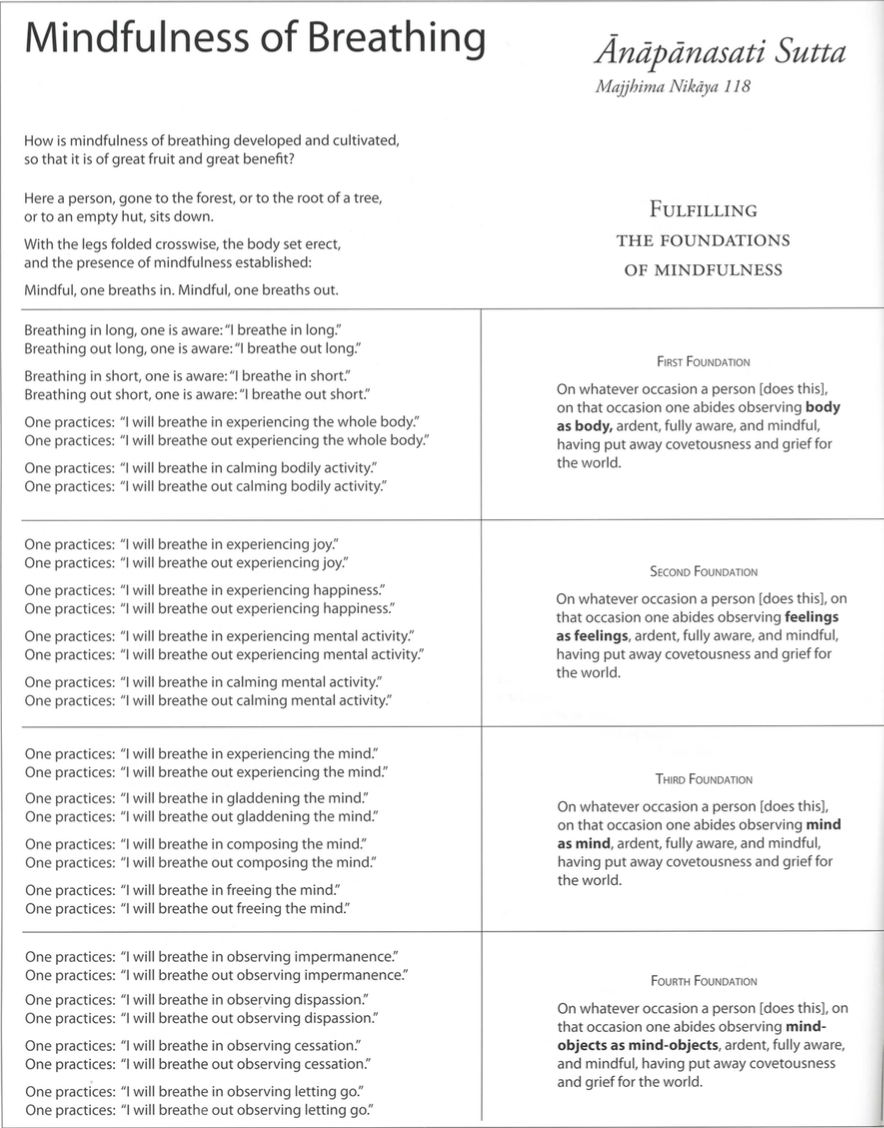Understanding Key Terms
developed: bhāvitā
This word is simply the causative form of the verb “to be,” and thus means “causing to be,” from which we get “development.” It is a word used often for meditation in general, and for certain kinds of meditation in particular, such as the development of loving kindness (mettā-bhāvanā).
cultivated: bahulākatā
Used often beside development as a synonym, this term literally meant something that is done (kata) a lot (bahuli). The way we develop a particular skill or a new habit is by constant practice and repetition—by “doing it alot.”
presence of mindfulness established: parimukhaṃ sati upaṭṭhapetvā
This phrase is idiomatic both in Pali and in English. Literally it calls for the establishment—standing or setting (-thapetvā) up (upa-)—of mindfulness around (pari-) the mouth or face (-mukhaṃ). Sometimes this has been taken to specify placing attention on the breath just where it enters the nose, but usually it is seen as a metaphor of intimate presence, as we might say something is “in your face” or we come “face to face” with something we scrutinize carefully.
mindful: sato
Mindfulness (sati) as a key term of Buddhist meditation has been construed in many different ways in recent usage, from the very broad (almost any degree of attentiveness or awareness), to the very narrow (a special mental factor arising only under very specific conditions). It is used here as an adjective of the meditator, and is defined functionally by what follows.
one is aware: pajānāti
Based on a verbal root meaning simply “to know,” it is the pivotal word in this text. What is the difference between breathing with awareness—consciously, deliberately, attentively, intently— and the breathing that occurs automatically at all times? Mindful breathing means knowing that you are breathing, not in an abstract or conceptual way, but immediately, viscerally, and uninteruptedly—moment by micro-moment.
“I breathe in…”: assasāmī ti
The immediacy of this experiential knowing is brought home by the grammatical construction of using the first person present tense set in quotation marks. The fragment “ti“or “iti” is simply a way of indicating that what precedes it is to be considered direct speech. The meditator’s direct knowing of her breathing is demonstrated again and again in this phrase, silently understood if not actually uttered to oneself.
one practices: sikkhati
In all that follows the verb is significantly altered from “to know” to “to train,” “to learn,” or “to practice.” This phrasing shifts the emphasis slightly from following what is already happening to taking some intentional stance toward, or participating creatively with, what now unfolds. It marks a subtle shift from an entirely passive to a somewhat more active or directed way of knowing the breath.
“I will breath in…”: assasissāmī ti
This movement is emphasized by a change in the tense of the verb, from present to future. It is still in the first person, and is still in direct speech, but now it points, at least figuratively, to what will occur in the next moment rather than in the present moment. Again, this brings a gentle sense of guiding the practice through the curriculum that follows.
experiencing: patisaṃvedī
Another important word in this text, this one is rooted in a word for “to know” that tilts strongly in the direction of “to feel.” In contemporary idiom these seem to be antithetical verbs, but in Buddhist thought the sensations of pleasure and pain are treated as a sort of direct knowledge. The prefixes amplify the feeling: “pati-” suggests falling back upon or getting in touch with something, while “saṃ-” brings a sense of totality or completion. This is a word for direct encounter or intimate contact with what arises in experience.
observing: anupassī
This is another word of great importance in mindfulness texts. At its core is the verb “to see” (pass-), and the prefix anu– means “following along” or going along with the way something naturally unfolds. Together they conjure a sense of observing, viewing, or watching what is happening. The term is sometimes rendered as “contemplating,” which works in some of its senses, but not when it suggests “thinking about” a problem. Like the words for “one is aware” and “experiencing,” the sense intended here has to do with a direct and experience-near, rather than a conceptual, mode of observation.
ardent: ātāpī
This adjective is based upon the word for “heat” (tapas). In ancient India all spiritual practice, and ascetic practice in particular, was viewed as a kind of “burning” or “heating up.” Much as a chemist might heat substances in a crucible to study the transformations that occur as it breaks down, the yogi or meditator would subject his mind and body to certain disciplines and examine the experiences that ensued. The image here is of intensive applied energy, such as one might exert while rubbing two sticks together to generate heat.
fully aware: sampajāno
Based on the root “to know,” like pajānāti above, the term is amplified here with the prefix saṃ– to suggest fullness or completeness. If pajānāti means “to know,” sampajāna means to know fully, to know comprehensively, to know in its entirety without interruption. It is often combined with the word for mindfulness (sati–sampajāna), in which case the former term refers to detailed, micro-awareness while the latter indicates a broader, more global awareness of an object as it is viewed in its wider context.
having put away: vineyya
The gentle “leading away” of the reflex to hold on to or push away from the objects of experience, resulting in the mental attitude of benign equanimity characteristic of mindfulness.
